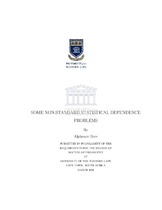| dc.contributor.advisor | Koen, Chris | |
| dc.contributor.author | Bere, Alphonce | |
| dc.date.accessioned | 2016-04-05T13:56:25Z | |
| dc.date.available | 2016-04-05T13:56:25Z | |
| dc.date.issued | 2016 | |
| dc.identifier.uri | http://hdl.handle.net/11394/4868 | |
| dc.description | Philosophiae Doctor - PhD | en_US |
| dc.description.abstract | The major result of this thesis is the development of a framework for the application
of pair-mixtures of copulas to model asymmetric dependencies in bivariate data. The main motivation is the inadequacy of mixtures of bivariate Gaussian models which are commonly fitted to data. Mixtures of rotated single parameter Archimedean and Gaussian copulas are fitted to real data sets. The method of maximum likelihood is used for parameter estimation. Goodness-of-fit tests performed on the models giving the highest log-likelihood values show that the models fit the data well. We use mixtures of univariate Gaussian models and mixtures of regression models to investigate the existence of bimodality in the distribution of the widths of autocorrelation functions in a sample of 119 gamma-ray bursts. Contrary to previous findings, our results do not reveal any evidence of bimodality. We extend a study by Genest et al. (2012) of the power and significance levels of tests of copula symmetry, to two copula models which have not been considered previously. Our results confirm that for small sample sizes, these tests fail to maintain their 5% significance level and that the Cramer-von Mises-type statistics are the most powerful. | en_US |
| dc.language.iso | en | en_US |
| dc.publisher | University of the Western Cape | en_US |
| dc.subject | Gamma-ray bursts | en_US |
| dc.subject | Konus | en_US |
| dc.subject | Copulas (Mathematical statistics) | en_US |
| dc.subject | Gaussian mixture model | en_US |
| dc.title | Some non-standard statistical dependence problems | en_US |
| dc.rights.holder | University of the Western Cape | en_US |

